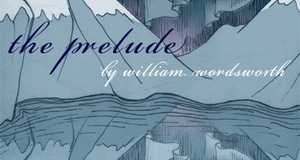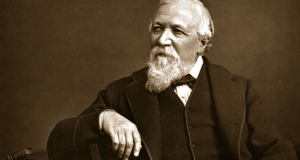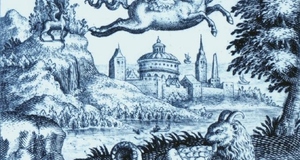Wordsworth's Tintern Abbey: Conveying Experience Through Nature
By
2015, Vol. 7 No. 09 | pg. 2/2 | « Comparing prior interactions at Tintern Abbey with present interpretations, seeks to point out the power of thoughts. Anna Foca, author of “Let me be the calm you seek: Imagination as (Safe)house in Wordsworth's Tintern Abbey,” explains how Wordsworth’s reliance on creativity allows him to fabricate an emotional comfort that subdues any fear or anxiety that is inherent in one’s life. The progression of time initiates emotions of fear or lack of control, which is apparent as people transition into different stages of their lives. Adaptability is the key necessary in order to overcome the initial discomfort that arises from an alteration in one’s life. Foca concentrates on the contrast Wordsworth presents between his experience five year prior to his current experience at Tintern Abbey and how his change in perception allows him to find peace of mind. Foca states, “the enabling power of this act of imagination…demonstrate for the reader how ‘Tintern Abbey’ becomes an embodiment of the theory which it explicates, the theory that imagination is an adequate remedy to suffering” (Foca). Throughout one’s life challenges will be presented that momentarily stunt the progress of an individual. These hurdles can be overcome by the imagination’s ability to fabricate an existence that realizes beauty as a primary quality of life and dismisses fear of the unknown, replacing it with hope. Tintern Abbey’s appearance changes very little, yet Wordsworth’s growth creates a sense of physical transformation. Foca places importance on the contrast of Wordsworth’s imagination from the past to present in order to understand the ability to modify one’s perceptions and derive comfort from the functioning of the imagination. Wordsworth’s depictions of the environment contribute more to comprehending the reality of minor physical change and emphasizing great emotional adaptation.“Tintern Abbey’s” clear organization of ideas within the poem’s stanzas, gives readers the impression of forward movement, bearing similarities to the structure of a story. Wordsworth makes a clear concerted effort to divide the poem into stanzas in order to show a clear cause and effect view of the way he interprets his environment. Each section of the poem relies on the stanza before in order to clearly illustrate progress and the conscious process of fabricating meaning from a mere perception of the natural world. Brian McHale focuses on the breaks between stanzas and they way that they provide relief for the reader to input their own interpretations of the text before moving onto a new section. McHale suggests that the reader’s ability to comprehend is encouraged through these spaces in the text, “It is where meaning-making is interrupted or stalls out, where the text breaks off and a gap (even if only an infinitesimal one) opens up, that the reader’s meaning-making apparatus must gear up to bridge the gap and heal the breech” (McHale, 16). Wordsworth’s long poetic narrative in “Tintern Abbey” seemingly has very little breaks or cuts, apart from the transition between stanzas. Each stanza allocates it’s own focus and it is the space between these stanza’s that Wordsworth allows the reader to connect the different ideas presented. The scarce amount of rest that the reader has throughout this poem signifies the narrative structure and the constant progression that Wordsworth seeks to achieve. The poem moves rather quickly from one line to the next, while the length of the poem makes it difficult to glimpse the prior stanzas and lines. This is meant to keep one’s focus forward, and not looking back to draw meaning. Growth through expression of thought is conveyed through these stanza breaks and ultimately brings the reader to what John Nabholtz considers the “final movement” of the poem. Nabholtz highlights the human interaction within the work as a pivotal moment that goes beyond a love of nature rooted merely on dependence or identity, and contributes to significant self-actualization, “it describes the mind no longer fulfilling primarily in various degrees of relationship with nature, but in reciprocity with another human being, and doing what nature herself cannot do—defeating mortal limitations by the power of memory” (Nabholtz, 229). While nature is shown to have a substantial influence on the personal growth of an individual, Nabholtz argues that interaction with others produces further meaning and understanding. These breaks, previously mentioned above, are an example of the interaction Wordsworth has with his readers, or more accurately, the interaction readers have with him. These gaps that are used to break up the long lines and stanzas within the poem give the reader ample time to reflect on images or emotions that Wordsworth may have evoked. These brief moments of contemplation supply readers with the comprehension of the previous lines that is necessary to move forward and retain a sense of structure within the narrative structure of the poem. Detaching the physical from his mental experience by accurately depicting the imagery in nature allows the imagination to re-organize Wordsworth’s illustrations into the reader’s own subjective constructions. Scott Hess notes the Wordsworth’s intent to dismiss the importance of his physical body in order to clearly articulate his perceptions in an organic way, “In composing scenes from this individual point of view, Wordsworth typically ignores or erases his own body, in the process isolating vision from the other senses and creating a ‘pure’ subjectivity seemingly detached from its environment, its own embodiment, and other forms of relationship” (Hess, 294). This strategy of blocking out one’s own physical inhabitance within an environment allows Wordsworth to solely focus on what he can absorb from his particular point of reference. Wordsworth’s analytical and physical recreation of his experience revisiting Tintern Abbey allows the reader to either familiarize their reading experience to compliment his interpretations or to gather resources to formulate their own understanding the impact of the landscape has on perception. Wordsworth’s metaphors seem to draw the reader away from objective and factual based interpretations of reality. Nicholas Williams, in his article for the Journal of Literature and The History of Ideas, hints at the idea that Wordsworth’s view of the landscape is a perception that is created, rather than a sensation that is grounded in objectivity, “[the abbey] has not been a chaos of meaningless raw sensation, as it might be to a blind man on immediately receiving sight, but has been composed in his mind as a meaningful landscape, perceived rather than merely sensed” (Williams). The metaphors that Wordsworth relies upon suggest a more abstract interaction with his environment, one that transforms his sense of sight into a subjective perception that contributes to his present emotions. This intent by Wordsworth, is a subtlety that is picked up by the reader and questioned. The metaphors within “Tintern Abbey” work towards granting the reader an understanding that is not restricted by the physical limitations of life, but the mental and imaginative creations that contribute the most substantial meaning and purpose. Finally, it is Wordsworth’s dependence on powerful, abstract metaphors that provides an imaginative experience that leaves interpretation open to readers. Wordsworth’s insightful metaphors grant significant meaning and purpose to his experience at the abbey, and allow memory to come to the forefront as a way of understanding the present, When these wild ecstasies shall be matured These lines suggest that memory is the foundation of interpretation. Wordsworth explains that memory inspires the ability to recollect sensations we once felt, but it is the recognition of how these past influences have changed that leads to progress. While the mind matures and “sobers” from past experiences of new discovery, the present self is able to comprehend the mind’s progression in it’s inability to contrast one’s own perceptions. The description of the mind as a “mansion” and a “dwelling-place” for “sweet sounds and harmonies” is a very abstract idea, yet aides in the formation of a concrete feeling that is intrinsic to human nature when an experience is found to be appealing and memorable. Wordsworth depicts the mind as a stationary source capable of retention and recollection, while also able to function as a creator of perspective through what he describes as “healing thoughts.” The force of Wordsworth’s “Tintern Abbey” is undeniably created through the poetic devices of imagery, line and metaphor, which help to convey abstract sensations to readers. These concrete forms of poetic mastery are the building blocks necessary for the transmutation of an individual experience into a form of mass communication where the reader is able to interact and relate to the ideas brought forth by Wordsworth. Poetry is powerful in its innate ability to evolve an objective fact-based experience into a subjective intellectual journey. The interaction between the reader and the poet is another quality the art form is capable of creating. While Wordsworth communicates his unique experience, readers are able to create a heightened dimension to the poem that spurs interaction through the functioning of one’s imagination. Imagination is the key to revealing truth, which can be discovered through a combination of objective and subjective perception. Wordsworth’s poetry teaches readers that an individual’s unique subjective perception is just as vital as one’s objective perception in order to comprehend truth. Truth is a goal shaped and brought to life by our experiences. It is how we choose to understand those experiences that define who we are as human beings. ReferencesFoca, A. (1998). "Let me be the calm you seek": Imagination as (Safe)house in Wordsworth's "Tintern Abbey".Bucknell Review,42(2). Hess, S. (2008). William Wordsworth and Photographic Subjectivity.Nineteenth-century Literature,63(3). McHale, B. (2008). Beginning to Think About Narrative in Poetry.Narrative,17(1), 11-30. Miall, D. (2000). Locating Wordsworth: 'Tintern Abbey' and the Community with Nature.Romanticism and Victorianism on the net,20. Nabholtz, J. (1974). The Integrity of William Wordsworth's "Tintern Abbey".The Journal of English and Germanic Philology,73(2). Retrieved from Jstor Peters, J.G. (2003). Wordsworth's Tintern Abbey.Explicator,61(2). doi:10.1080/00144940309597762 Smith, C.J. (1954). The Contrarieties: Wordsworth's Dualistic Imagery.PMLA,69(5), 1181-1199. Retrieved from Jstor Williams, N. (2012). ''Glad Animal Movements'': Motion in Wordsworth's ''Tintern Abbey'' and ''The Two-Part Prelude.'' Partial Answers: Journal of Literature and The History of Ideas,10(1), 11-28. Wordsworth, W. (1798). William Wordsworth, "Lines Written a Few Miles above Tintern Abbey" - Hypertext Reader - Romantic Circles High School - Romantic Circles. Retrieved from http://www.rc.umd.edu/sites/default/RCOldSite/www/rchs/reader/tabbey.html Suggested Reading from Inquiries Journal
Inquiries Journal provides undergraduate and graduate students around the world a platform for the wide dissemination of academic work over a range of core disciplines. Representing the work of students from hundreds of institutions around the globe, Inquiries Journal's large database of academic articles is completely free. Learn more | Blog | Submit Latest in Literature |


















